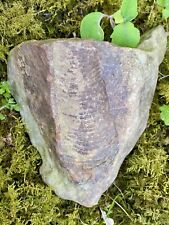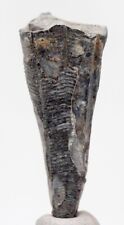RARE CONULARIID Fossil Extinct Sea Life Mineral Specimen Finis Shale TEXAS For Sale

When you click on links to various merchants on this site and make a purchase, this can result in this site earning a commission. Affiliate programs and affiliations include, but are not limited to, the eBay Partner Network.
RARE CONULARIID Fossil Extinct Sea Life Mineral Specimen Finis Shale TEXAS:
$12.99
This specimen weighs 5.75 grams. It measures 34 mm x 13 mm x 13 mm.I offer a shipping discount for customers who combine their payments for multiple purchases into one payment!The discount is regular shipping price for the first item and just 50 cents for each additional item!
To be sure you get your shipping discount just make sure all the items you want to purchase are in your cart.
sales you win are added to your cart automatically.
For any "buy it now" items or second chance offers, be sure to click the "add to cart" button, NOT the "buy it now" button.
Onceall of your items are in your cart just pay for them from your cart andthe combined shipping discount should be applied automatically.I offer a money back guarantee on every item I sell.
If you are not 100% happy with your purchase just send me a message to let me know
and I will buy back the item for your full purchase price. Hi there. I am selling this really amazing Conulariid fossil. I bought it at a gem show in Arizona and it was found in Jack County, Texas. It is really amazing, and very detailed. It would be a great idea to have in a classroom for a teacher, or to have as a part of a gem and mineral and fossil collection. It was one of the nicest and most detailed ones that I have ever seen. I have never come across one that looked so complete and perfect. This is the fossil of an animal that lived in the sea 312 Million years ago! THE DETAIL OF THESE SPECIMENS IS AMAZING!!! It's really interesting and I hope it finds a good home out there. If you have any questions please let me know. Thanks so much for visiting my store!Here's some info about this mineral from wikipedia:
ConulariidaFrom Wikipedia, the free encyclopediaJump to navigationJump to searchConulariidaTemporal range: Upper Cambrian–Upper from the Mississippian (c. 360 to 325 mya) of Indiana; scale in mm.Conularia gratiosa (fossil conulariids) (Salem Limestone, Middle Mississippian; Spergen Hill, Indiana, USA) 3.jpgTwo Conularia gratiosa specimens from the Salem Limestone aged to the Middle Mississippian.Scientific classificationeKingdom: AnimaliaPhylum: CnidariaClass: StaurozoaOrder: †ConulataeClade: †ConulariidaMiller and Gurley, 1896GeneraSee text.
Conulariida is a poorly understood fossil group that has possible affinity with the Cnidaria. Their exact position as a taxon of extinct medusozoan cnidarians is highly speculative. Members of the Conulariida are commonly referred to as conulariids and appear in the fossil record from the mid or late Cambrian Period until the Triassic.[1]Contents1 Structure2 Fossil record3 Lifestyle4 Phylogeny5 Pearls6 List of genera7 References7.1 Bibliography8 External linksStructureThe conulariids are fossils preserved as shell-like structures made up of rows of calcium phosphate rods, resembling an ice-cream cone with fourfold symmetry, usually four prominently-grooved corners.[2] New rods were added as the organism grew in length; the rod-based growth falsely gives the fossils a segmented appearance. Exceptional soft-part preservation has revealed that soft tentacles protruded from the wider end of the cone, and a holdfast from the pointed end attached the organisms to hard substrate. The prevailing reconstruction of the organism has it look superficially like a sea anemone sitting inside an angular, hard cone held perpendicular to the substrate. Conulariid shell is composed of francolite with carbonate ion concentration 8.1 wt%. The lattice parameters of conulariid apatite are a = 9.315(7) Å, c = 6.888(3) Å.[3] The fine structure of their shell comprises multiple lamellae of alternately organic-rich and organic-poor layers.[4]
Fossil record
Close-up of a conulariid from the Mississippian of Indiana; scale in mm.
Conularia milwaukeensis from the Middle Devonian of Wisconsin.With the exception of the Ediacaran Vendoconularia, which may or may not be a conulariid at all,[5] the Conulata fossil record begins with undeniable specimens in the Upper Cambrian (Hughes et al., 2000) and extends without significant break through numerous major mass extinctions. The Conulariids finally disappear from the fossil record during the Lower Triassic stage of the Triassic Period (~245 million years ago).
In North America, conulariids are generally more common in rocks of Ordovician and Carboniferous age.
LifestyleConulariids apparently lived only in normal-marine waters, such as the oceans and inland seas. Fossils are commonly found in rocks representing offshore, even anoxic, marine bottom environments. This has led some scientists to infer that these animals may have drifted planktonically for some or all of their lives, ultimately being buried in the anoxic sediments beneath the oxic waters in which they lived. However, basic functional considerations (such as the great weight of the shell) make such interpretations difficult to maintain.
PhylogenyAbout 20 genera and 150 species are known,[6] but except for local occurrences, Conulariids are relatively uncommon.
The conulariids were originally thought to be anthozoan cnidarians. However, the lack of septa or other features diagnostic of anthozoans led researchers to abandon this hypothesis. Ivantsov and Fedonkin (2002) posit that the conulariids were ancestrally tri-radially symmetrical, as typified with Vendoconularia, typical of the structure seen in Vendozooans.[7] Conulariids are, however, not generally thought to be a part of the Ediacaran biota as their fossil record starts at Upper Cambrian.
It is now also thought that the conulate trilobozoans derived their fourfold symmetry from a sixfold symmetry, as seen in Vendoconularia. This in turn, is thought to be originally derived from an ancestral disk-like trilobozoan three-fold symmetry.
Conulariids have generally been thought to be of Cnidarian affinity, occupying a position near the base of the Cnidarian family tree. However, since the 2010s, authors consider conulariids to be most closely related to the Scyphozoa, or the "true jellyfish". A possible arrangement is as relatives of the extant stalked jellyfish.[8] However, the nature of Conulariids and their phylogenetic relationships to other organisms remain poorly understood, and the supposed cnidarian affinity remains speculative.
[icon] This section needs expansion. You can help by adding to it. (June 2008)PearlsConulariids produced pearls within their shells, similar to the way molluscs such as oysters, other pelecypods, and some gastropods do today. These pearls give a clue as to the internal anatomy of the conulariid animal. But due to their calcium phosphate composition, their crystal structure, and their extreme age, these pearls tend to be rather unattractive for use in or as decorative objects.[9]

Related Items:
Conulariid Fossil RARE • River Rock with Fossil Imprint from Mohican River Ohio
$40.00
RARE CONULARIID Fossil Extinct Sea Life Mineral Specimen Finis Shale TEXAS
$12.99
$24.99



